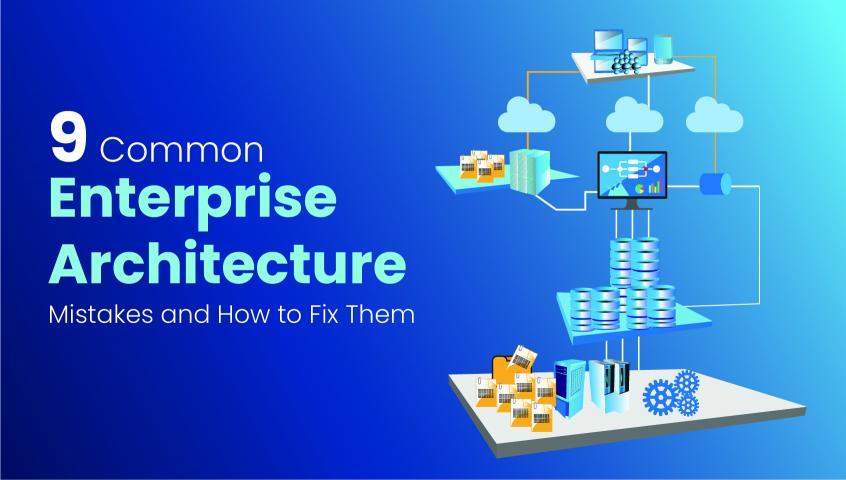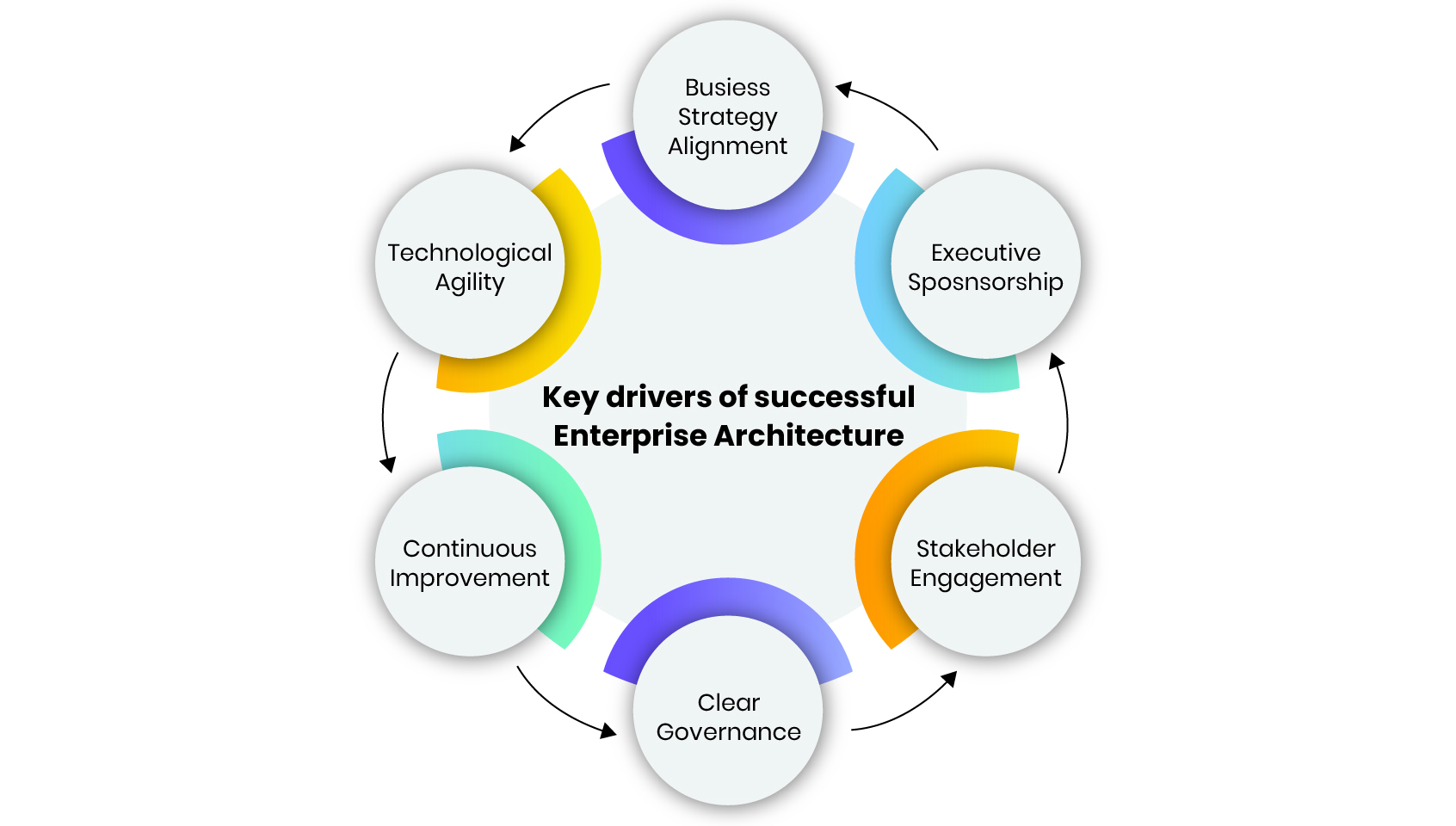
With the rise of new technologies and changing customer expectations, many businesses are turning to Enterprise Architecture initiatives to help them to stay ahead of their digital transformation game. Enterprise Architecture is a complex process of aligning tech capabilities with business strategy and demands careful planning and thoughtful execution. An effective Enterprise Architecture can help organizations optimize their IT infrastructure by developing a comprehensive blueprint of an unified, efficient, and cost-effective strategy. When done appropriately, it can have an immense and positive impact on the organization’s operations. However, if mismanaged, it can have expensive repercussions. In this article, we will discuss the nine biggest mistakes organizations must avoid in order to remain competitive and future-proof their businesses.
9 common enterprise architecture mistakes to avoid
Enterprise Architecture Initiatives Not Aligned with Business Objectives
As digital revolution has become a necessity, businesses are naturally rushing into new initiatives without first determining how they will benefit the business. Most of the IT teams are spending more time justifying the existence of their initiatives by modeling processes, information, and systems than they do delivering on them by giving solutions to pressing concerns.
If you adopt this approach to Enterprise Architecture, you risk adding unneeded complexity to processes by making modifications or investing in technologies that don't address employees' essential concerns. Without credible reason, it will be more challenging to win over stakeholders and secure funding for projects within an organization.
Effective Enterprise Architecture requires aligning with clear, business goals. Enterprise Architecture can be viewed as a filter through which you can examine the efficacy of your company's IT systems and the technologies you choose to implement or modify in order to achieve your objectives. Having a clear vision of the final outcome will provide you with the criteria you need to make investment analysis much easier.
“Make sure Enterprise Architecture processes are dynamic and adaptable, opt for diplomacy over strict governance, adopt a collaborative strategy, never lose sight of how it aligns with business value, and be empathetic in your approach”
Not Adopting Customer-Centricity
When designing an enterprise architecture, it's vital that your efforts are aligned with customer-centricity. Successful transformation requires transparent and well-communicated plans for how the design will bring about the desired results for the business. Organizations now face a significant challenge in satisfying customers' expectations for an unified and consistent experience across all channels and touchpoints.
Enterprise architecture design that centers on the needs of its customers is a radical shift from the conventional thought process. Customer-centric strategy poses a threat to the status quo and may need a shift in business operations in the long term. Companies risk falling behind in the market if they don't implement a customer-centric design.
Unable to Consolidate Core Objectives and Capabilities
Businesses that fail to consolidate their core objectives and competencies run the risk of developing silos. When multiple units within an organization face the same problem and implement partially redundant solutions, it bogs down operations and hinders the organization's ability to reach its objectives. An enterprise architecture design that would improve cross-departmental communication and collaboration may not be implemented if departments are siloed from one another.
The formation of silos can be avoided by analyzing the company's digital tools, processes, and policies. A capability-driven business architecture can be developed for an organization by first determining its shortcomings and its strengths. To avoid siloed divisions and unnecessary duplication of effort, it is necessary to first establish a capability-driven business architecture.
Technological Emphasis Over Agility and Business Objectives
Most Technology leaders overlook the business value model when concentrating on the technical parts of enterprise architecture design. This enables many IT leaders to debate about the best technological options instead of focusing on how to effectively support current and future business needs.
Technology leaders must facilitate, encourage, and swiftly accelerate necessary changes as business requirements are dynamic in nature. They should aim to design a system that is both adaptable and robust, as this will provide the company more leeway to compete in the market.
Communication Gaps Within the Organization
Enterprise architects often face issues with communication and collaboration between different departments. Architects at every level of an organization want to contribute to its strategic transformation, but they may find it difficult to cooperate with their peers at times. There is a two-way communication gap, which is very unfortunate. Some enterprise architecture teams may act insular and unapproachable, as if they were isolated from the rest of the company and the decision-making process. Enterprise architecture teams may also be excluded from IT and business stakeholders' transformation plans because they are seen as a hindrance.
Enterprise architecture teams must be involved in functional areas to clarify and persuade stakeholders to adopt their recommendations. When faced with constant change, stakeholders generally focus on reducing IT costs, speeding up time to market, or realizing value in the short term.
Architects can assist everyone, notably business unit owners, in anticipating future cost estimation cycles. Architects may aid organizations in developing a plan that meets both immediate and long-term needs by highlighting the distinctions between strategic and tactical methods and long-term and short-term decision making.
Dealing with The Unstructured Data
If you want EA to be successful, it is not necessary to gather every piece of data available within your organization. However, the information you collect needs to be comprehensive and gives a genuine picture of your company as a whole. Because of this, its volume is likely to remain high, and if you don't have a method to analyze it holistically, you'll have trouble deriving useful insights from it. Data that isn't well-organized presents a significant barrier to analysis, utilization, and communication.
Having a platform to present Enterprise Architecture progress to business executives and stakeholders is helpful for project buy-in, as they will want to see business success metrics that justify the planned changes. This not only aids in analysis and understanding, but also in keeping a centralized database of all Enterprise Architecture data. A lack of convincing justification for a project will make it difficult to gain backing.
Clinging to the Existing Enterprise Architecture Values
Without considering what is needed for scalability, an enterprise architecture is doomed to fail. Without a plan, you'll have trouble achieving your business objectives and maximizing efficiency. You'll have to start over from scratch when you realize what you built doesn't meet the operational needs of the business, which is expensive.
Maintaining a flexible perspective is essential when designing and implementing a system that will need to grow or adapt with the business. Due to the rapid evolution of technology and the inherent unpredictability of any endeavor, it is recommended that you employ open-architecture platforms and services.
Shortchanging Security
Security should always be a top priority when a business implements technological innovations. Even though Enterprise Architecture can help with data compliance, the Enterprise Architecture team is rarely involved in such efforts. When considering Enterprise Architecture use cases and the extent to which it permeates a business, it is surprising that Enterprise Architecture is not involved in data security planning.
Keeping security out of the enterprise architecture design process is risky because it puts systems, applications, and vulnerable data to attack. Due to the ever-increasing sophistication of cyber threats and the frequent occurrence of major cyber-attacks on businesses, security must be integrated into enterprise architecture from the very beginning, during the design phase.
Prior to final approval, security must be considered during the design, planning phases, as well as during testing and validation. Security-by-design mandates prioritizing design considerations in light of potential risks, values, and repercussions to the business from vulnerabilities and intrusions.
Strive for excellence

In fields as diverse as IT and business, it's common to find exceptionally skilled people who aim for perfection in their work. Even while it's admirable to strive for perfection, doing so when creating an enterprise architecture is a huge mistake, especially if you care about futureproofing or scalability. That's vital but focusing too much on it can cause a wide range of issues, especially in the realms of architecture and design.
Complexity and expense will increase dramatically as we work toward the ideal enterprise architecture that top management envisions for the next few years. It causes delays in delivery, longer times to create systems, increased likelihood of errors and downtime, and higher overall expenses.
Tips for Successful Enterprise Architecture Initiative
- To make sure EA generates relevant, contextualized value, you should begin with a well-defined change objective and a mapping of your efforts to overarching business goals.
- Engage all employees across departments and levels of seniority, including C-Suite members, stakeholders, and other key players to gain a comprehensive insight that will outline areas for change.
- Prioritize the collection and presentation of ongoing, high-quality data to keep plans on track and to be able to communicate progress to peers.
- Businesses of all sizes need a governance perspective to manage risk proactively. Having a full picture of the application's lifespan lets you see underlying problems and reassure stakeholders that the tools are being used properly.
- Utilize Enterprise Architecture technologies that encourage cooperation and promote adaptability and nimbleness during times of change.
Legacy Platform Re-Architecture for Better Digital Business POV by Qentelli
Delivering Value to Business with Enterprise Architecture
An organization's ability to adapt to change depends on its enterprise architecture, which is strategic rather than technical endeavor. Though Enterprise Architects aren't absolutely necessary for an organization success, not having one widens the gap between strategy and execution that can be closed by planning and designing.
Enterprise Architecture success relies on the strategic participation of all stakeholders. You will not only be able to get beyond the typical stumbling blocks associated with change management, but you will also be able to establish unprecedented levels of synergy between teams and operations. If you have questions regarding Enterprise Architecture or require any support with your strategic and transformative initiatives, please contact us at info@qentelli.com

